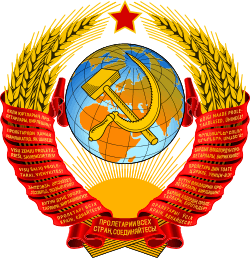Energy policy of the Soviet Union
The energy policy of the Soviet Union was an important feature of the country's planned economy from the time of Lenin onward. The Soviet Union was virtually a self-sufficient energy nation; the development of the energy sector started with Stalin's autarky policy. During the country's 70 years of existence, the primary way of securing economic growth were based on large inputs of natural resources. But by the 1960s, this method was less efficient. In contrast to other nations who shared the same experience, technological innovation was not strong enough to replace the energy sector in importance.
During the later years of the Soviet Union, most notably during the Brezhnev stagnation era, Soviet authorities exploited fuel resources from inhospitable areas, notably Siberia and the Far East. Construction of industry in these locations required massive input by the Soviet regime. Energy resources were still the backbone of the Soviet economy in the 1970s, as seen during the 1973 oil crisis, which put a premium on Soviet energy resources. High prices for energy resources in the aftermath of the 1973 oil crisis led the Soviet authorities to engage more actively in foreign trade with First World countries, particularly Europe (natural gas) and Japan (oil). In exchange for energy resources, the Soviet Union would receive First World technological developments. So, despite the stagnation, the Soviet Union under Leonid Brezhnev moved from being an autarkic economy to a country trying to integrate into the world market.
A historical perspective
Under Lenin (1918-1923)
- See also New Economic Policy
Within Gosplan, the Soviet Economic planning bureau, there were two divisions directly involved with this topic. One was focused on Electrification and Energy. Another was focused on Fuels.
Under Stalin before World War II (1924-1940)
- 1928 Stalin's First Five-Year Plan
Despite many of the targets being unbelievably high (a 250% increase in overall industrial development, with a 330% percent expansion in heavy industry), remarkable results were achieved:
- Coal: 64.3 million tons (compared to 35.4 million tons in 1928, and a prescribed target of 68.0 million tons)
- Oil: 21.4 million tons (compared to 11.7 million tons in 1928, and a prescribed target of 19.0 million tons)
- Electricity: 13.4 billion kWh (compared to 5.0 billion kWh in 1928, and a prescribed target of 17.0 billion kWh)
During World War II (1941-1945)
By energy sector
Electricity
Electrification of the country was a focus of the Soviet Union's first economic plan (GOELRO plan).
Oil/petroleum
Within the USSR State Planning Committee (Gosplan), there was a State Committee for the Oil Industry which handled this area of the economy.
Natural gas
A separate Soviet gas industry was created in 1943. Large natural gas reserves discovered in Siberia and the Ural and Volga regions in the 1970s and 1980s enabled the Soviet Union to become a major gas producer. Gas exploration, development, and distribution were centralized in the Ministry of Gas Industry, which was created in 1965.
See also Gazprom.
Hydroelectric
- See also Dnieper Hydroelectric Station
- Hydroelectric power stations built in the Soviet Union
